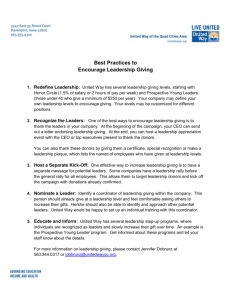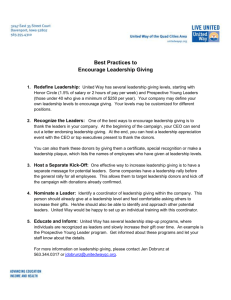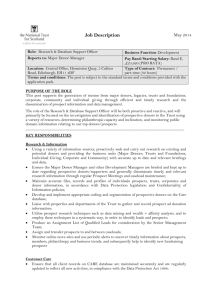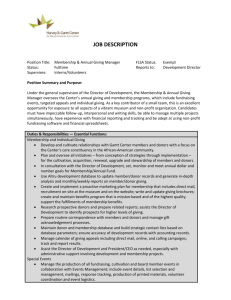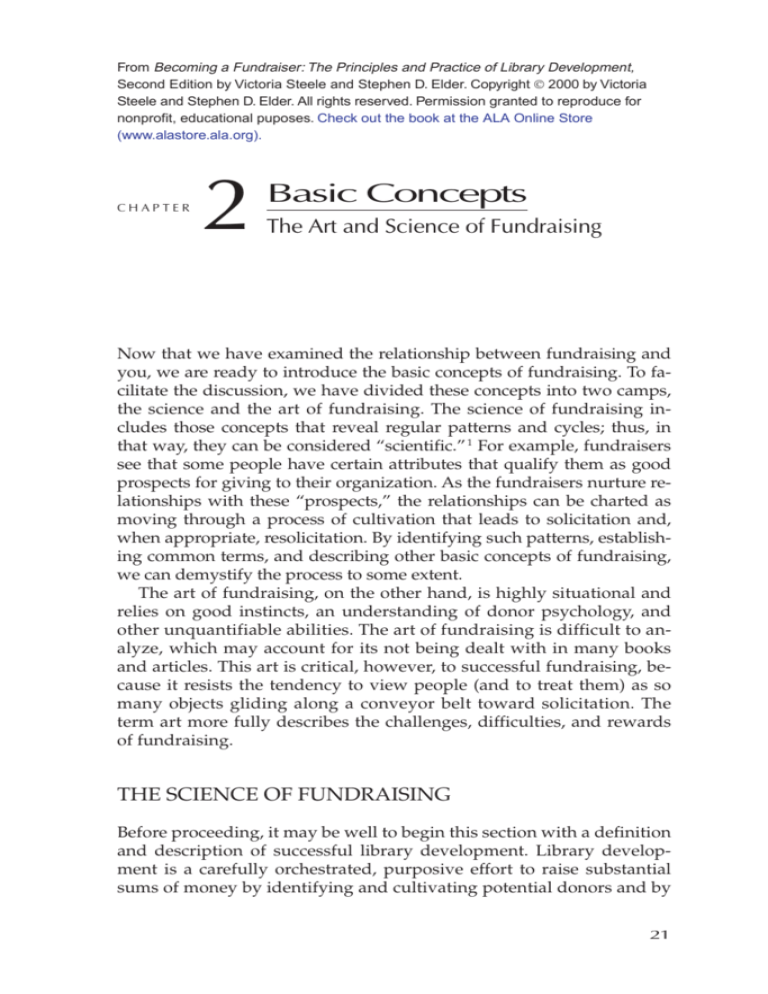
From Becoming a Fundraiser: The Principles and Practice of Library Development,
Second Edition by Victoria Steele and Stephen D. Elder. Copyright 2000 by Victoria
Steele and Stephen D. Elder. All rights reserved. Permission granted to reproduce for
nonprofit, educational puposes. Check out the book at the ALA Online Store
(www.alastore.ala.org).
CHAPTER
2
Basic Concepts
The Art and Science of Fundraising
Now that we have examined the relationship between fundraising and
you, we are ready to introduce the basic concepts of fundraising. To facilitate the discussion, we have divided these concepts into two camps,
the science and the art of fundraising. The science of fundraising includes those concepts that reveal regular patterns and cycles; thus, in
that way, they can be considered “scientific.” 1 For example, fundraisers
see that some people have certain attributes that qualify them as good
prospects for giving to their organization. As the fundraisers nurture relationships with these “prospects,” the relationships can be charted as
moving through a process of cultivation that leads to solicitation and,
when appropriate, resolicitation. By identifying such patterns, establishing common terms, and describing other basic concepts of fundraising,
we can demystify the process to some extent.
The art of fundraising, on the other hand, is highly situational and
relies on good instincts, an understanding of donor psychology, and
other unquantifiable abilities. The art of fundraising is difficult to analyze, which may account for its not being dealt with in many books
and articles. This art is critical, however, to successful fundraising, because it resists the tendency to view people (and to treat them) as so
many objects gliding along a conveyor belt toward solicitation. The
term art more fully describes the challenges, difficulties, and rewards
of fundraising.
THE SCIENCE OF FUNDRAISING
Before proceeding, it may be well to begin this section with a definition
and description of successful library development. Library development is a carefully orchestrated, purposive effort to raise substantial
sums of money by identifying and cultivating potential donors and by
21
22
Basic Concepts
soliciting gifts from them when their goals and wishes are congruent
with the library’s goals and priorities. The goal of the development program is to enhance the library’s independence. Therefore, fundraising is
judged to be effective not principally on the basis of dollars raised, but to
the extent that gifts contribute to the strategic vision for the library. Successful fundraising depends on the leadership and participation of the
library director. For purposes of the discussion in this chapter, we assume adequate levels of staffing to support the development program;
matters of staffing are fully described in the next chapter.
The basic vocabulary of fundraising concerns donors and potential
donors. Potential donors are referred to as prospects. The universe of
prospects can be further differentiated: If little or nothing is known of a
prospect, she is sometimes called a suspect. When a relationship has
been established with a prospect, the prospect is said to be in cultivation. Past donors are prospects, too, if you think they will make additional gifts. Established donors, especially if they participate actively in
the organization, are often euphemistically called volunteers.
The MAGIC Ingredients
How do you recognize a prospect? Professional fundraisers evaluate
prospects by asking a series of questions, which we have formulated
into the mnemonic MAGIC:
M
A
G
I
C
Does the prospect have means?
What is the person’s age and are there heirs?
Is the person a giver?
Is the person involved in your organization?
Does the person have contacts?
A person must have either personal means or contacts in order to be
a valid prospect. By “contacts” we mean more than simply knowing
people; we mean that the person is in a position to give away other
people’s money—through membership on a philanthropic board, for
example. Assuming that prospects have means or contacts, it is necessary to find out if they are givers. There are a number of ways to find
out about a person’s giving history. If you are in a university, your development office can tell you about the prospect’s record of giving to
your institution. If the person is highly visible in the community or has
a personal foundation, the development office’s staff can also research
that person’s public giving patterns. Another way to find out about a
prospect’s giving is simply to talk with the person informally about his
or her community involvements.
Copyright 2000 by Victoria Steele and Stephen D. Elder
Basic Concepts
23
Age is an important issue because most people who give major gifts
do so in their fifties and sixties. In this key age bracket, a person without heirs who has means can often be an excellent prospect. Involvement is also essential. A person must have some reasonable tie to your
organization in order to be a viable prospect.
Prospects are seen as moving through a six-step development cycle
(see figure 1). In the first step, a prospect (or, at this stage, a suspect) is
identified. The second step consists of involving the prospect in the organization, whether through an invitation to an event, a board appointment, or a lunch date. Orchestrated involvement is known as
cultivation, and it can last for months or years. Cultivation leads to solicitation, or asking the prospect to make a gift. A successful solicitation is
followed by stewardship, or the careful nurturing and continuing involvement of donors. Careful stewardship leads to resolicitation.
FIGURE 1. Prospect development cycle
The development cycle holds true for almost all major gifts. It even
holds true, with slight variations, for gifts that seem to come from out
of the blue—the process was going on, but nobody knew about it. In
these instances, the process might look more like this: The prospect
sees herself as someone who has the means to make a gift and is interested in doing so; she identifies herself. She may or may not get involved in the organization (the cultivation step). She elects to make a
gift, soliciting herself, in effect. The organization responds gratefully
(the stewardship step), the donor likes it, and she eventually makes
Copyright 2000 by Victoria Steele and Stephen D. Elder
24
Basic Concepts
another gift. This pattern also holds for bequests except, obviously, for
the last step: resolicitation.
The most significant exception to the model involves memorial gifts.
Memorial gifts, which account for a large percentage of giving, essentially bypass the early stages of the cycle. They are an emotional and
healing response to a painful occurrence: the death of a loved one. In
these instances, the donor comes to you. Though such donors bypass
the early stages of the cycle, they frequently require sensitive stewardship. Resolicitation, however, may or may not be possible.
The development cycle takes time. One rule of thumb is that the
typical major gift requires thirteen contacts over the space of two to
three years. Many development professionals managing a large number of prospects think of the cycle as requiring about three years.
“Megagifts” take much longer. One fundraiser, when asked how she obtained a $20 million gift for her university, replied, “Simple. We cultivated the donor for twenty years.” Multimillion-dollar gifts almost
invariably involve long-term relationships.
Organizing Fundraising
Fundraisers commonly think of donors and prospective donors as falling
into one of two camps: annual givers or major givers. Just as librarians
sometimes have thought of themselves as being either in public services
or in technical services, development professionals will often identify
themselves with major gifts or with (as they would say) annual funds.
Why is the distinction between major giving and annual giving important? There are three reasons. First, as we said above, there is usually a division of labor along the lines of major giving on the one hand
and middle-range and annual giving on the other. Just as it would not
be appropriate for someone in technical services to be concerned with
service guidelines for the reference department, so it would not be appropriate for someone you had hired to do major-gifts work to be concerned, in more than a general way, with direct mail or with the
Friends of the Library group.
The second reason for understanding the important distinction between annual giving and major giving is that it is basic to thinking about
prospects. In assessing prospects’ potentials, you are really asking in
which camp they belong. Should they be cultivated by means of the
Friends or should they receive individualized attention? If they should
receive the latter, what is your next step in cultivating the relationship?
The third and most important reason has to do with how the library
director, as the head fundraiser, prioritizes her time. If the library has
an ambitious development program, the director will want to give
highest priority to major-gift prospects; she will not want to be too
Copyright 2000 by Victoria Steele and Stephen D. Elder
Basic Concepts
25
concerned with, say, building the membership of the Friends or overseeing mail appeals.
Annual Giving
Most of us are annual givers: people who make gifts, generally in the
$50 to $100 range, in response to periodic (not necessarily annual) appeals, such as those from educational television and local privately
supported radio stations in on-air pledge drives. We also give in response to mail appeals, known in the fundraising business as “direct
mail.” There is a seemingly endless number of nonprofit organizations
that use direct mail, including museums, zoos, environmental organizations, literacy promoters, universities, and library Friends groups.
Telemarketing is another string in the annual fund bow; many of us
have grown accustomed to receiving yearly phone calls from the annual funds of our alma maters. Door-to-door solicitation, an approach
perfected by the Girl Scouts, is another method used to raise large
numbers of low-level contributions.
Major Giving
Major gifts are multithousand-dollar gifts. There is no hard-and-fast dollar figure attached to a major gift because such gifts should be assessed
relative to the range of gifts an organization normally receives. A small
public library might consider $10,000 a major gift. New York Public Library might think of a major gift as being $100,000. Many fundraisers
think of $25,000 as being an arbitrary minimum level for a major gift.
Major gifts are made (1) after a significant period of one-on-one cultivation, (2) after the careful formulation of a strategy for the prospect, and
(3) after the prospect has been asked directly to make a gift by the most
prestigious, effective, and appropriate person or persons connected
with an organization. In the case of university libraries, one of these solicitors will usually be the library director. Contrary to popular belief,
professional fundraisers rarely ask people for money. Remember, they
are Sherpa guides. The fundraiser’s role is to help the library director
meet, get to know, and effectively solicit major-donor prospects. The differences between annual gifts and major gifts are summarized in the accompanying box below.
Middle-Range Giving
A middle area exists between a true annual giver and a major giver;
this range usually falls between $100 and $10,000 for most types of libraries. Givers in the middle range may be either generous annual
givers who really do not have the ability or inclination to give more, or
they may be potential major donors who are not yet making gifts of
Copyright 2000 by Victoria Steele and Stephen D. Elder
26
Basic Concepts
ANNUAL GIFTS
MAJOR GIFTS
Gave each year up to about
$5,000 annually
A commitment of significant
resources that may be pledged
in installments
Usually cash
Cash, securities, or other
appreciated assets, such as
real estate
Solicited each year
Solicited over time based on
the donor’s circumstances
Solicited by phone, by mail, or
by a volunteer or staff member
Solicited in person and often
with a fully developed proposal
great size. For this reason, donors who fall into this category should receive special attention. Research and assess, as thoroughly as possible,
the potential of middle-range donors to give larger gifts, and be sure
that they receive attention from both the library director and the development staff member in charge of annual giving.
Support Groups: The Fundraising Swimming Pool
In fundraising terminology, a Friends of the Library organization is a
support group. In a small-scale fundraising program with no major-gift
effort, the Friends may be the entire fundraising effort, forming the annual fund for the library and providing events and publications for its
members. In a full-scale program with annual, middle-range, and
major giving, the Friends group will loom less large, but even here it
can function as an important element in the development cycle. An
analogy demonstrates this role and also provides a way of showing how
different types of givers fit into a development program.
A Friends group is like a swimming pool. Most people, the annual
givers (that is, the Friends themselves), enter the pool from the shallow end. Major givers enter the pool from the deep end. Both groups
get into the pool by virtue of having made a gift. The Friends provide a
place for both to swim: The pool provides a mechanism for the cultivation and stewardship phases of the development cycle. Sometimes a
Friend—who entered from the shallow end by virtue of a relatively
small gift—will swim all the way to the deep end and make a major gift;
sometimes a Friend from the deep end will swim to the shallow end
and persuade one of the annual givers to cross to the deep end. Provided that the Friends are geared to serve a development purpose, and
provided that their activities and events are fun and stimulating, they
Copyright 2000 by Victoria Steele and Stephen D. Elder
Basic Concepts
27
can be invaluable in providing a vehicle for involvement (more about
this in chapter 6).
Working with Prospects
Now that we have established some basic vocabulary, concepts, and
models, we are ready to discuss the initial question you might ask
about prospects.
Who Will Give to My Library?
One thing is certain: The vast majority of large gifts will come from a
relatively small number of individual donors, most of whom will already be known to you or to your organization. The simplicity of this
idea belies its importance. For example, you may be barraged with
ideas from well-meaning people who are certain you are overlooking a
number of obvious prospects, or that your base of donors is not “broad
enough.” Your librarians may ask why you are not “going after” a particular foundation or corporation, especially one that they may have
read about recently in the press. And your donors will sometimes insist
that you approach a very rich, well-known public figure whom you
do not know at all and whose interest in your cause is doubtful at best.
These suggestions are time-wasting follies.
We repeat: The vast majority of large gifts will come from a relatively small number of individual donors. It is commonly said in fundraising that 80 percent of the total money you receive will be donated
by 20 percent of your donors. Recent research has shown that, increasingly, more of the overall money being raised is coming from
fewer donors, to the point where as much as 90 percent of a campaign
goal can come from as few as 10 percent of the total donors.2
The conclusion to draw from this data is that you can expect your library fundraising to reflect a similar pattern. Do not expect that a large
number of little donors will be responsible for most of your gifts. People
who do not understand this 90–10 phenomenon will often suggest that a
fundraising goal be divided into equal shares and parceled out among a
number of prospects. They will say, “Let’s divide this $1 million goal
into ten equal shares of $100,000. That way, we only have to find ten
donors. Simple!” Unfortunately, fundraising does not work that way.
Most donors will be individuals who are already known to you or your
organization. The donor prospect target, illustrated in figure 2, indicates
by a series of concentric rings who is most likely to give, less likely to
give, and least likely to give to your library. In the bull’s-eye are your
best prospects; as you proceed outward through the successive rings,
the prospects are less and less likely to respond to your appeals. As a
fundraiser, you are not looking to make a convert out of a nonbeliever—
Copyright 2000 by Victoria Steele and Stephen D. Elder
28
Basic Concepts
someone in the outer ring. Indeed, as far as conversion goes, you are
mainly looking for people who already believe in your cause on some
level. Therefore, your energies should be directed—in addition to looking after your past donors—to bringing into the fold people who have
demonstrated an interest in libraries, books, and learning.
Corporations and well-known high rollers are unlikely to be significant benefactors. Corporate and foundation giving together account
for only 10 percent of all charitable giving in our country; gifts from
individuals, including bequests, account for 90 percent.3 The donor
group to your library will reflect this, and your concentration on priority prospects should, too. Even foundations or corporations that do
contribute to an organization generally do so at the direction of individuals within them who have clout.
FIGURE 2. Donor prospect target
Copyright 2000 by Victoria Steele and Stephen D. Elder
Basic Concepts
29
Major donors rarely come from the large category of “vague others.”
Though it is sometimes possible, with careful planning and the right
connections, to recruit some of these vague others who have no ties at all
to your organization, they are not usually good prospects. Your most
important prospects, then, are people who are involved in your library
and especially those who have given to you in the past. Individuals are
the key; devote your efforts to those who care about your library. The
time that you expend on them, as opposed to foundations and corporations and vague others, should reflect your awareness that as much as
90 percent of your support will come from them and that individuals
are, moreover, the keys to foundation and corporation giving as well.
There is a category of prospect that is the opposite of a vague other.
For lack of a better term, this is the “busybody.” Busybodies are usually small-time donors, but they command and expect the attentions
normally given to a major-gift prospect. Busybodies typically take
your time with leads that turn out to be worthless, think they know
better than you do what directions the library should be taking, and
may frequently refer to their “wills.” In working with busybodies, be
particularly sure of your purposes and niche (ideas that will be discussed in detail in chapter 4), and be willing to draw the line with
them. In the final analysis, establishing some distance from such individuals is sometimes not a bad idea.
You can test the validity of the donor prospect target yourself by
thinking about how you respond to the voluminous quantities of direct
mail that you receive personally. You probably throw a good deal of it
away without even opening it, but every so often a piece will arrive that
coincides with some feelings you have about a given issue, whether it is
handgun control, civil rights, or an environmental concern. Whatever it
is, you decide you must support that cause, and you write a check. Professionals who solicit contributions through the mail understand perfectly the way these donations come about. They are not trying to
convince everyone of the worthiness of their cause; they are simply trying to find those people who, to some extent, believe in it already.
How Do I Ask Them?
The donor prospect target also provides a useful framework for beginning to think about your solicitation methods as they relate to your
prospects, whichever circle they are in. The solicitation methods you
have available to you, from most personal to least personal, are: (1) faceto-face (whether with an individual or a group); (2) telephone (or with
groups, telemarketing); and (3) mail (or with large groups, direct mail).
Whenever you are trying to get a message across, the more personal the
Copyright 2000 by Victoria Steele and Stephen D. Elder
30
Basic Concepts
method, the more effective it is. Because it is impossible to deliver every
solicitation personally, you should vary your approach from most personal to least personal as you move from your best prospects in the
inner circle to your least likely prospects in the outer rings.
For example, though many people may normally detest receiving
telephone solicitations, when you receive a call from an enthusiastic
eighteen-year-old from your alma mater, you may find that you are
disarmed and that it is practically impossible to turn the student down.
By virtue of its being more personal, telemarketing is usually more effective than direct mail; it is far more difficult to say no to a person
than it is to crumple a letter.
Fundraisers know that telemarketing is best applied to that category of prospects for whom it will be most effective. They would not, of
course, phone their established major donors—the innermost ring of
their own concentric circles—about making a small gift. Rather, within
the university setting, for example, telemarketing is used to contact a
certain category of alumni who may or may not have previously responded to a telemarketing or direct-mail solicitation, but who in any
case can be expected to have some degree of interest in the university
and some means with which to make a modest gift.
When fundraisers use direct mail to target those prospects in the
outer circles, they try to overcome the handicap of this least personal
of all solicitation methods by making their letters as personal as possible. Toward that end, they will sometimes customize their letters to incorporate the recipient’s name not only into the salutation but also
into the body of the letter. They will also write the letters in the second
person in the most immediate manner and most engaging tone possible. Direct-mail marketers also use every trick at their disposal to get
you to open the piece and to read it. They know, for example, that the
eye will scan the salutation area and pause for a postscript. That is
why you will rarely see a direct-mail piece without a P.S.
To What Will They Give?
As we said in chapter 1, people give to big ideas, to bold and exciting
plans. Prospects will be drawn to the idea of a whole new kind of library
or a library that establishes a collection for their special area of interest,
particularly if it is the first of its type. Donors are not usually drawn to
projects that appear to involve ongoing operations (for example, retrospective conversion) or that appear to be huge and insurmountable (for
example, preserving the general collections of the library).
Donors give to satisfy their needs rather than the library’s needs,
and donors’ needs usually involve projects that will “make a difference”
Copyright 2000 by Victoria Steele and Stephen D. Elder
Basic Concepts
31
rather than projects designed to maintain already established resources
in the library. If there is any exception, it is that most donors understand the need for funds to support book purchases; projects concerning other ongoing needs have little appeal, however.
If you decide that what your library most needs is retrospective
conversion, preservation, or facilities improvements, you will have to
be very creative in packaging these opportunities. For example, you
might design a gift opportunity involving the creation of a conservation treatment laboratory. Your package would allow you to name the
facility for the donor, and it would emphasize the “big idea” behind
preservation, namely, preserving our culture’s written record. The proposal might include dramatic illustrations of before-and-after treatments. The opportunity should be specific and carry a finite price
tag—attributes that make it attractive to donors.
Some projects, no matter how important they are to you, cannot be
glamorized for your donors. No amount of creativity will overcome
their lack of appeal. Storage problems may fall into this category.
Though storage problems are critical ones for many libraries, their solution may or may not offer anything tangible to donors. Trying to disguise such projects may hurt your credibility with donors. Though it is
sometimes possible to work with donors to bring their needs exactly
into line with the library’s needs, sometimes the adjustment is not possible. When developing gift opportunities, remember that you are trying to serve the donor’s needs and interests as well as your own.
Gift opportunities usually take the form of a brief written proposal
tailored to the person who will receive it. The substance of the proposal is presented in person; the document’s purpose is to serve as a
summary and follow-up to the verbal presentation. Because a gift opportunity emphasizes a big idea, it is quite different from a grant proposal, which spells out all the details and minutiae of a project. It will
be written (usually by your development director) with the idea of
achieving congruence between the library’s interests (why you want
and need the gift) and the potential donor’s interests (why he or she
might want to make the gift).
How Do I Thank Them?
People give to worthwhile projects and to attractive gift opportunities,
but they also give to be recognized for their giving. Recognition for
most major donors goes far beyond mere expressions of thanks. Most
major donors want to see their names placed on something: on a bookplate, on the arch of a room, on a piece of equipment, or on a plaque on
a wall along with the names of other donors. The need to attach a
Copyright 2000 by Victoria Steele and Stephen D. Elder
32
Basic Concepts
donor’s name to a gift opportunity is so important that “naming opportunities” are part and parcel of gift opportunities, and fundraisers think
about naming opportunities as they design gift opportunities.
It should go without saying that, in embarking on a library development program having a major-gifts component, the director must be
prepared to provide suitable forms of recognition. Few librarians have
difficulty with the idea of naming funds for donors, but it seems that
some are disinclined to provide more tangible forms of recognition. This
reluctance is a problem, because it is these tangible forms of recognition
that often motivate givers. Therefore, if you wish to have a high-stakes
development program, you must be prepared to attach your donors’
names to rooms, to branch libraries, and even to the main library itself.
Many donors also expect to be made to feel important and to be accorded special privileges. They get this VIP treatment regularly from
all the people and organizations that are courting them for gifts. In the
university setting, major donors and prospective donors are not paying
for their football tickets, their parking permits, or most of their meals
on campus. It is important to know this so you will be prepared for requests from donors and prospective donors for special library privileges, parking arrangements, and, in a university situation, help with
student admissions. It is up to you how to respond to these requests
and to know where to draw the lines. But be aware of the expectations
of donors and the treatment they are likely accorded by other institutions or departments within your own institution. Remember that, in
embarking on a development program, you are sending a signal to
prospective donors that you are playing the “cultivation game.” If you
refuse to grant a particular request, your prospects may disqualify you
from play. Sometimes it is helpful to recognize that some requests
(such as courtesy parking) are harmless and easy; others are dangerous and difficult (such as those that involve requests for titles, office
space, and even token salaries in connection with a gift). Library privileges are among the things that are uniquely yours to give away, and
we think you should. In truth, very few of your donors will actually use
their borrowing privileges. Draw your lines where they really matter.
THE ART OF FUNDRAISING
The art of fundraising involves a sense of what motivates giving, an understanding of donor psychology, and an appreciation of the importance
of strategy. Mastery of the art means a grasp of the subtleties of human
values, needs, attitudes, and behavior as they relate to philanthropy.
Copyright 2000 by Victoria Steele and Stephen D. Elder
Basic Concepts
33
Donor Psychology
Motivations for giving are complex. People’s reasons for giving are
highly personal, unique to each individual, and closely linked to their
values and attitudes, elements that make up a person’s mind-set. In
the end, most people give for what they think giving will do for them,
not for what it will do for you. Donors’ giving behaviors are based on
a combination of thoughts and emotions, their past experiences with
giving, and a sense of proper timing, either financially or otherwise.
These motivating factors are seldom entirely understood or recognized by
the donors, and they often intersect and overlap. Your job is to be attuned
to your donor prospects, to really listen (not just with your ears but also
with your intuition) to what makes them tick.
Abraham Maslow and others have identified “belongingness”—the
need to affiliate with others and to be accepted—as a basic human
need. They also have highlighted “esteem needs”—the need for approval and recognition from others—as a basic human goal. In order to
satisfy the “belongingness” need, many fundraising appeals emphasize
the benefit of becoming part of the “family.” In order to satisfy esteem
needs, many fundraising programs offer donors some kind of public
recognition for their support.
Harold Seymour, author of a well-known book in the fundraising
field, identifies two motivations for giving.4 He believes that there are
two universal aspirations: first, “to be sought,” to feel that we are valuable to someone or something external to ourselves, and, second, to be
“a worthwhile member of a worthwhile group,” to feel a pride in our
association with and contributions to an organization or a community
that itself is vital and merits admiration.
If people give in order to fulfill certain basic needs, they also do so in
order to express how they see themselves in relation to the world.
Many people who give do so out of a sense of duty. They feel they have
profited from their work in the community, and they want to give
something back. They feel a moral obligation. Some people who give
do so because it gives them a sense of pleasure. Such people feel a personal pride and involvement in their benefactions. Many givers have a
spiritual or mystical idea of giving. They may believe that if they give,
they will get back.
Why do people give to a particular institution? Belief in the mission
of the institution is the most important factor in motivating a major
gift. Without an interest in the organization or what it is trying to accomplish, a person will never make a gift, no matter how exciting the
organization’s projects are or how charismatic its askers. Closely
linked to belief in the organization is confidence in and regard for its
Copyright 2000 by Victoria Steele and Stephen D. Elder
34
Basic Concepts
leader. As we have said, donors respond to dynamic and visionary
leaders. They want to be inspired. Third, givers’ perceptions of the financial stability of the institution affect their ideas about the institution’s mission and its leaders. People usually give to stable organizations,
not to troubled ones.
Beyond their belief in the mission of the institution and the vision
of its leader, givers consider other factors when contemplating a gift.
For one thing, donors want to go with winners. They often give to a
program because others are giving to it; few donors want to go it alone.
They give to opportunities, not needs, and they give to programs
where they feel they can make a difference.
Ego frequently plays a part in giving. Many philanthropists are inspired by the wish, perhaps common to everyone, to immortalize
themselves. Even though they may tell you otherwise, many donors
also crave adulation. Successful fundraisers know that it is wise not to
underestimate a person’s need for self-aggrandizement.
Finally—and this point cannot be emphasized too strongly—donors
give if asked to give but do not give if they are not asked. When all is
said and done, the number one reason people give is because they are
asked. Potential donors do not read your mind or respond to hints.
They must be asked directly for a specific gift.
Donor Strategy
Now that we have a sense of what motivates giving and some understanding of basic donor psychology, we can turn to the issue of donor
strategy. Developing strategies for communicating with prospects is
the heart of fundraising. Research about how people communicate,
generally referred to as communication theory, illuminates the four
variables of donor strategy. For example, some communication researchers have organized their studies around this query: “Who says
what to whom using what method with what effect?” Modified for
fundraising communication, the question becomes: “Who asks what of
whom using what method with what effect?” In terms used by communication theorists, the person asking for the gift is in the role of the
message source, the description of the gift opportunity is the message
itself, the prospect is the recipient of the message, and the method by
which “the ask” is made is called the message channel.5
Though most fundraisers do not use the vocabulary of communication theory, these four elements are, in fact, precisely the ones used by
people formulating solicitation strategies. When fundraising staff
members meet, they discuss four variables as they relate to each
prospect. They strategize about (1) who should ask the prospect for the
Copyright 2000 by Victoria Steele and Stephen D. Elder
Basic Concepts
35
gift, (2) what form the gift opportunity should take, (3) the method
to be used to ask the prospect, and (4) the unique characteristics of
the prospect.6 For example, let us describe a hypothetical strategy
meeting at a university to discuss Mr. and Mrs. Prospect. The Prospects
have no specific intellectual interests. However, they have a child attending the university, are looking for a charity to support, and would
like to associate themselves with an academic institution. The meeting
of the university’s development team to discuss the strategy for the solicitation might go something like this:
Q. What would make a good gift opportunity for the Prospects?
A. They would respond well to something that we could attach their
name to.
Q. Why would they respond well to that?
A. Because they would enjoy public recognition for their contribution.
Q. What magnitude of gift are they capable of?
A. Our research shows that they could make a seven-figure gift.
Q. How about naming a prominent room in our new library building after
them?
A. That would be perfect; they find the idea of libraries tremendously empowering and enriching.
Q. Are they ready to be asked?
A. No, they need more cultivation.
Q. What form should this take and what should our timetable be?
A. Cultivation should be at the highest level and take the form of intimate gatherings. Once every three months at least, the director
should see them for lunch or dinner; we will also want to involve
the president. Either the president or the director should solicit
them in about a year, depending on how the relationships mature.
The fundraisers have formulated a basic strategy for the Prospects.
When it becomes time to ask the Prospects for a gift, the fundraisers
once again will discuss them with reference to the four variables: who
asks, for what and for how much, by what method, and what unique
characteristics about them are most pertinent? Because the fundraisers
are discussing a major gift, the method would always be face-to-face; but
Copyright 2000 by Victoria Steele and Stephen D. Elder
36
Basic Concepts
the specifics of where the message might be delivered and under what
circumstances would be matters for careful consideration. These are
discussed in detail in chapter 5.
This paradigm works for annual giving also. Say, for example, that
you want to recruit a new Friends member whom you think may have
potential for a major gift. Who invites the prospect to join? How—by
letter or phone? At what giving level should he be asked to join? What
makes you think he will respond favorably?
As a library director, you are frequently the message source. And
you have going for you the two most important characteristics that
make your message persuasive to others: expertise and trustworthiness.
When a message’s recipients see its source as expert, attractive, or
successful, they are usually more likely to be swayed. People want to
believe in the expertise, authority, competence, and status of someone
in a position of power.
In order to earn someone’s trust, you must have credibility. Credibility consists of four elements: your experience, your knowledge, the
way you present yourself, and your associations.7 Your experience has
brought you to your position, your track record has withstood the
scrutiny of the formal selection process, and your personal qualities
have held up under the scrutiny of the “off-the-record” selection
process. Your knowledge, from the point of view of your prospects, will
primarily involve your academic background—the schools you attended,
your advanced degrees; most donors will not be much impressed by
your publications or prominence in professional organizations. Your
presentation involves your appearance, the way you speak, your personality, and your professional demeanor. Last, your associations—
your connections—can help establish introductory and temporary trust
in situations where you would not otherwise have it. In chapter 5, we
will have more to say about earning credibility when you find yourself
in one-on-one situations with donors.
Art and science, magic and technique, inspiration and application—
these are the elements of successful fundraising. You will blend these
elements in your unique way as you build your development team and
find your niche, topics to which we will turn next.
Notes
1. On the science of fundraising, see Kathleen Kelly, Effective Fund-Raising
Management (Mahwah, N.J.: Lawrence Erlbaum, 1998), p. 11.
2. Kathleen S. Kelly, Fund Raising and Public Relations: A Critical Analysis
(Hillsdale, N.J.: Lawrence Erlbaum, 1991), pp. 278–279.
Copyright 2000 by Victoria Steele and Stephen D. Elder
Basic Concepts
37
3. American Association of Fund-Raising Council (AAFRC) Trust for Philanthropy, Giving USA: The Annual Report on Philanthropy for the Year 1989 (New
York: American Association of Fund-Raising Council, 1990), p. 6.
4. Harold Seymour, Designs for Fund-Raising (New York: McGraw-Hill,
1966), p. 6.
5. These elements of communication were first described in this way by
Bruce Lannes Smith, Harold Lasswell, and Ralph D. Casey in Propaganda, Communication, and Public Opinion: A Comprehensive Reference Guide (Princeton, N.J.:
Princeton University Pr., 1946), p. 3. For an overview of these elements and research on related factors that affect communication, see Richard E. Petty and
John T. Cacioppo, Attitudes and Persuasion—Classic and Contemporary Approaches
(Dubuque, Iowa: Wm. C. Brown, 1981), pp. 60–94.
6. An oft-repeated development adage reduces fundraising to “selecting
the right person to ask the right person, the right way, for the right amount, for
the right reason, at the right time.” See Fisher Howe, “What You Need to Know
about Fund Raising,” Harvard Business Review 63(2) (March–April 1985): 18–21.
We tend to be in sympathy with the commentator who likened this advice to
“buying stocks that only go up”; that is, we find this formula both pat and imprecise, and prefer to use communication theory in discussing donor strategy.
7. These elements of credibility are identified by Robert B. Miller and
Stephen E. Heiman in Conceptual Selling (New York: Warner Books, 1987), pp.
219–222. Miller and Heiman’s research and ideas are discussed in greater detail
in chapter 5.
Copyright 2000 by Victoria Steele and Stephen D. Elder

